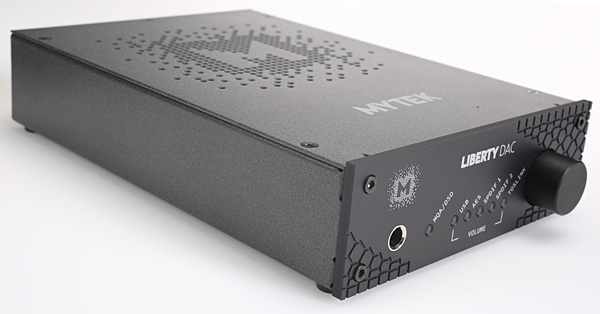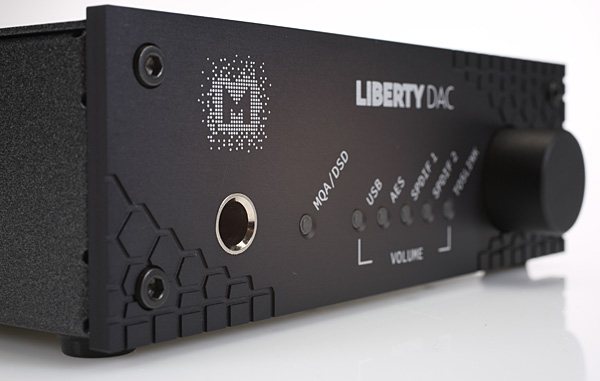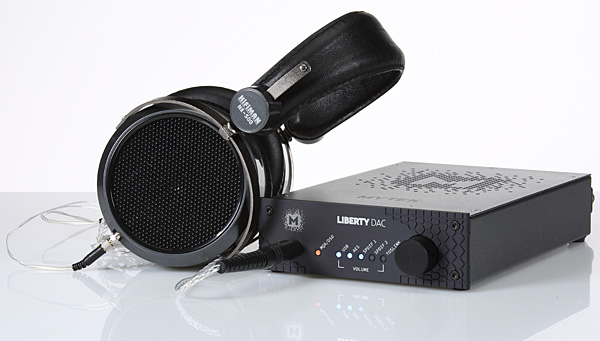| Columns Retired Columns & Blogs |
Give me Liberty or give me Kalista :-) .............
No less remarkably, this explicitness came without undue brightness or other treble penalties: The Mytek's sound was clear and wide open, with zero darkening of timbres or rounding of edges—yet note attacks, however believably sharp, were never overcooked, and textures never became gritty.

Although most of the recordings stored on my laptop are 16/44.1, I used the Liberty to play a number of high-resolution files as well, including an MQA of male vocal ensemble Cantus performing Eric Whitacre's Lux Aurumque, from their While You Are Alive (original CD, Cantus CTS-1208). It seemed to me to achieve a sort of playback ideal: Yes, the voices came across with clarity and without coloration, the physicality of the singers believably suggested, the recording space seemingly reproduced in both sound and scale. But what won me over was that, even at low volumes, this recording was musically convincing, and satisfied me—yet the DAC (and the rest of my system) also rewarded me when I wanted to hear it played loudly, for the simple pleasure of doing so.
Some of my time with the Liberty was spent streaming music from Tidal HiFi (16/44.1), usually with agreeable results. "Sloth," from Fairport Convention's Full House (Hannibal), sounded really fine, as tonally well balanced as from the LP (if not as well textured: the late Dave Swarbrick's electric viola still sounds better on vinyl), with as much wallop from Dave Mattacks's drums as I've ever heard from that recording. Dave Pegg's electric bass sounded full yet tuneful, his rhythmic style already distinct from that of his predecessor, the no-less-talented Ashley Hutchings (Full House was Pegg's recorded debut with the band). I also enjoyed the recording of Chopin's Nocturne 13 in c by Youra/Yura Guller—the same recording, first released in 1956 on Ducretet-Thomson, was reissued last year on a 10" LP by the Electric Recording Company (now sold out). Via Tidal and the Liberty DAC, some of the hoped-for atmosphere came through, although the LP experience is far more generous with die-away—in the sounds of the piano and the room—and the forcefully played bass lines that begin just after the halfway mark had less weight and force in the digital realm. Still, via this DAC and a $20/month Tidal subscription, I got more than half of what I needed to hear from this and other similar old, weird, mono piano recordings—and that's still an awful lot.
Streaming MQA files from Tidal proved a mixed bag—though here I advise the reader that all of my stated praise and blame may have less to do with the Liberty DAC than the MQA files themselves. Comparing the MQA and 16/44.1 versions of "Since I've Been Loving You," from Led Zeppelin's III (Atlantic), I thought the latter sounded more dynamic/less compressed, and altogether more involving; in particular, the kick drum in the MQA version sounded less like a drum than someone tapping his thumb on an open mike. And comparing the 16/44.1 and MQA versions of the title track of Sonny Rollins's Tenor Madness (Prestige) was like comparing two different kinds of awful: In the former, peaks were harsh in Rollins's sax solos and the hardest struck notes from pianist Red Garland; the latter was just muddy and veiled and muddy. My beat-up LP—it came from a college library, for God's sake—made both digital formats sound ridiculously bad.

But when I compared different Tidal streams of David Bowie's The Rise and Fall of Ziggy Stardust and the Spiders from Mars—a landmark album, and easily one of his five best—the MQA version was wildly superior: Mick Ronson's electric guitar roared, Mick Woodmansey's drums sounded less compressed than ever, Trevor Bolder was revealed as one hell of a bassist (with a Bruford-esque restraint in some numbers), and Bowie's voice and acoustic guitar sounded just perfect. "Five Years" was cry-worthy, as it should be, and it wasn't until the last violin notes at the end of "Rock 'n' Roll Suicide" had faded away that I noticed I was standing up, and probably had been for a while.
Similarly, through the Liberty DAC, the streamed MQA version of Kanye West's Ye (Def Jam) was so superior to the 16/44.1 files that I couldn't help wondering why anyone with access to the former would waste time on the latter. In the 16/44.1 version, the synthesized bass in "Yikes" wasn't as menacing as that in the MQA version; likewise, the MQA version of "Wouldn't Leave" turned the front end of my room into a big, airy (but not pallid) soundscape in which West's dead-center, grainless lead voice was flanked by the slightly more distant but no less real-sounding voice of supporting singer Jahron Anthony Brathwaite (aka PartyNextDoor). I was enchanted.
Of the time I spent playing CDs through the Liberty's S/PDIF input—using my Sony SACD/CD player as a transport, bypassing its own DAC—I can say only: Assuming that the Liberty's performance is indeed typical of Mytek DACs, I regret having waited so long to try one in my system. In terms of overall tonal balance, the Mytek and the Sony—the latter with its default PCM filter engaged—were similar, yet the audible contrast between the two was striking: neither bettered the other in terms of momentum and musical flow, but the Sony's output was flat as wallpaper compared to that of the timbrally, texturally, and spatially nuanced Mytek Liberty. Listening through the Liberty to Pieter Wispelwey play the Saint-Saëns's Cello Concerto 1, with Daniel Sepec and the German Chamber Philharmonic Bremen (SACD/CD, CD layer, Channel Classics CCS SA 16501), I heard more vivid colors and more vibrant instrumental textures, plus much more physical space between soloist and orchestra. And in "Quite Rightly So," from a 2009 reissue of Procol Harum's Shine On Brightly (CD, Salvo CD018)—a somewhat bright and gritty recording, even at its best—vocal sibilants were unexaggerated and sounded more natural, the highest notes from Matthew Fisher's Hammond organ less keening: the song was much more listenable, without sounding less lively or vibrant.

A few words about the headphone amp
My headphone experience is meager, and while I'm pleased by the apparent good health of that segment of our industry, I have no interest in listening to music that way. But I keep on hand a borrowed pair of AudioQuest NightHawks 'phones, for reviews such as this. Driven by the Mytek Liberty, the NightHawks sounded much the same as when driven by other contemporary DAC-headphone amps—a little darker than neutral but very well detailed—and certainly no worse.
Conclusions
It was while driving the Liberty DAC with my Sony "transport" that I realized: I really didn't want to send the review sample back to Mytek.
Were money no object, I'd have a hard time choosing between the Liberty and the even more natural-sounding HoloAudio Spring "Kitsuné Tuned Edition" Level 3 DAC ($2499, footnote 1). And the Mytek's performance was less limpid, the music it produced less beautiful, than that of the Métronome Kalista DreamPlay One CD player ($43,000), a product that seemed capable of turning every recording it played into the sonic equivalent of a Maxfield Parrish painting.2
My regard for the Mytek Liberty has as much to do with what it is as with what it does. What it is is an intelligently engineered, well-made, pleasant-to-use DAC that performs near the state of the art and carries a three-figure price tag. Ten times out of ten, that's the sort of thing that captures my interest and wins my heart. Very highly recommended.

Give me Liberty or give me Kalista :-) .............

Try a Martin DRS2, beautiful sounding, a little dark, really well set up.

DACs are not much differing in perceivable performance. Even Jason Stoddard has mentioned that DACs are boring. ( I think he's right )
It seems like Audiophile's mostly 24k Golden Ears struggle to describe significant performance differences in DACs.
Tyll's 2015 "Big Sound" Event in Montana had nobody pointing out one DAC as the Outperforming Design ( including the often praised but dirt cheap Yggy from Schiit ).
It seems to make sense that this $1000 DAC will please about as much as any other DAC out there.
I like the Mytek Liberty, I'd like it more if it were named the Warsaw but not enough to be inspired to impulse "Buy-It-Now". hmm.
Thanks for tell'n us about it.
Tony in Michigan

Because of ever changing digital tech, getting ahead of state of the art in DACs and streamers seems to be nearly impossible. I too think that DACs these days are all a little closer to state of the art than not within reason (DCS not withstanding.) As always, a preferred sonic signature will be available at all price ranges. If you like incisive without harshness, Mytek DACS are ideal. A similarly priced DAC that's to me a perfect blend of detail and warmth without venturing into overly euphonic coloration is the AYRE CODEX. Speaking of euphonic coloration I'm also intrigued about the Border Patrol DAC but havent had a chance to listen.

Dudley, you review overpriced audio gear—gear that is the epitome of bling. Some self reflection in the future please, if you can manage. Thank you.

Dudley, thanks for your enjoyable review. I'm getting more and more interested in this DAC - you obviously like it.
But here's the problem....you did what most audio reviewers do, hoping nobody notices. Instead of comparing the Liberty with key competitors that anyone would cross-shop if they were in the market for the Liberty, you pick out a couple of irrelevant DAC's waaaaay outside the Liberty's bracket.
No comparison to Border Patrol, or RME, or appropriate Schiit models for example. And we all know why, don't we? You'd have to start ranking them, and that would obviously make the unfavored brands unhappy. So instead of that you do what you always do - you say something like "....it's almost as good as xxx brand costing more than twice as much." So everyone's happy, right?
No hurt feelings. Everyone's a winner.
The trouble is, it makes the whole exercise a pointless sham - don't you agree?
Go on - tell us what you really think about this DAC. Be dangerous.

Mr. Dudley, a Editor for Stereophile Magazine, has years of experience writing articles and reviews. I like reading his articles, and find them informative. Art (Arthur) is his name, in case readers missed it.

Apologies to Art. The use of his surname was entirely accidental but thanks for pointing out the error and correcting me. I'm delighted that you enjoy Art's comparisons and feel no reason to comment. I also enjoy his reviews, in spite of this facet of them. They would be more useful if the comparisons were realistic, in my personal opinion. But we've all got opinions, I grant you that.

The world is grateful for your intervention, Mr. Manners. Where would we be without you?

If that was a serious question directed at me - my guess is that you'd be with your head buried deep in the sand. Afraid of asking a simple question or pointing out a blatant truth.
I'm sure Mr Dudley doesn't mind the odd question that challenges his findings. If he does, that would be sad. But I suspect he'd prefer to do without the creepy protection of fan boys and speak for himself.

Sorry, I must have clicked on a wrong reply button. The busybody is the one above who pestered you about calling out Dudley.
I’m with you on this one. Apologies for the mess.

From the comment about busybodies, it would seem the pot is calling the kettle black as that is exactly what a busybody would do. Websters has a great definition! Of course, my comment fits right in, but at least I'll admit that. Whether I agree with Mr. Dudley or not, I'll have the decency to address him with a bit of respect and common courtesy. I'm not in the habit of addressing someone by their last name, but I suppose someone with an axe to grind might, and you don't agree with someone's point view, then it seems all bets are off. I'm anxious to hear what vitriol I might receive in response!
Cheers,
Terry

The use of Art's last name was accidental, apologies were offered several posts ago. Please relax and focus on the substance of the post, if you can manage to get past that typo. Thanks.

If you think that Art Dudley has earned your respect, that's good for both of you. His earning my respect is still work in progress. :))

A good DAC really opens up the sound at the front end of your system.
Done right it puts life into the music.
Done poorly it wrecks everything that comes after it in your chain.
MQA is the new decoding scheme which Tidal in particular brings into your home---sometimes as a better sound if the stars are aligned.
This Mytek DAC is relatively affordable and does many things very well, including a low cost entry into all things MQA.
I will buy one as one of my internet systems is due for an update.
Thanks Art.
Nice review.

I'm currently using a Metrum Acoustics Octave NOS dac. Is this the Mytek dac a better step up?

I love this test signal: "a crosspicking pattern in which two downstrokes are played in rapid succession, followed by a similarly rapid upstroke; the first note in each pair of downstrokes is played as a rest stroke—the plectrum comes to rest, however briefly, against the adjacent string as the note is played—giving that note a distinctive attack."
Most audio specifications are obsessed with frequency and spectrum, which is the defining characteristic of vowels or their musical equivalents, tones. Frequency spectrum implies a continuous, repetitive waveform idealized as superposition of sinusoids. (Fourier math only works if you integrate time from negative infinity to positive infinity, have infinite resolution and keep the complex phase space information intact)
Music, like speech, devotes 95% of the time and energy to vowels/tones; but the signalling information content of the other 5% is at least as important. These sounds are the consonants: how the tones start, stop and transition. Accurate reproduction of the musical expression means getting the waveforms and timing of the consonants correct, even when they are a fraction of a millisecond.
It is in this relatively un-explored area that many audio debates fall: analog vs. digital, SS vs. Tube and metal vs. fabric domes, high order vs. low order crossovers. Anti-aliasing makes it nearly impossible to follow musical consonants to the limits of hearing resolution digitally (around 3 microseconds). This is where over-sampling and ultra-low jitter come in, plus any other mathemagic discovered at Mytek, dcs, etc.
OTOH, CD aficionados have trained their hearing to pre-ringing and other digital artifacts that are "impossible to hear" according to the prevalent machine model of hearing, which has been distorting audiological research for 150 years since Helmholtz declared the cilia acted like tuning forks.
For that matter, every knob, function and plug-in that changes the sound of the signal inherently introduces temporal distortion. All processing, whether analog or digital, has to conflate more than one point in time of the original microphone signal and changes the waveforms of consonants. This is temporal distortion.
Audiophiles learned to by-pass tone controls, and yet practically all recordings use equalization, dynamic modification or delay operations (reverb and echo). All of these distort the musical consonants.
In fact, the act of mixing two microphone signals together or splitting one signal into left and right (panning) distorts the consonants and any natural reverb present in the recording; so mixing and mastering are distortion.
Kudos for escaping this vicious circle! Have to check out that recording.